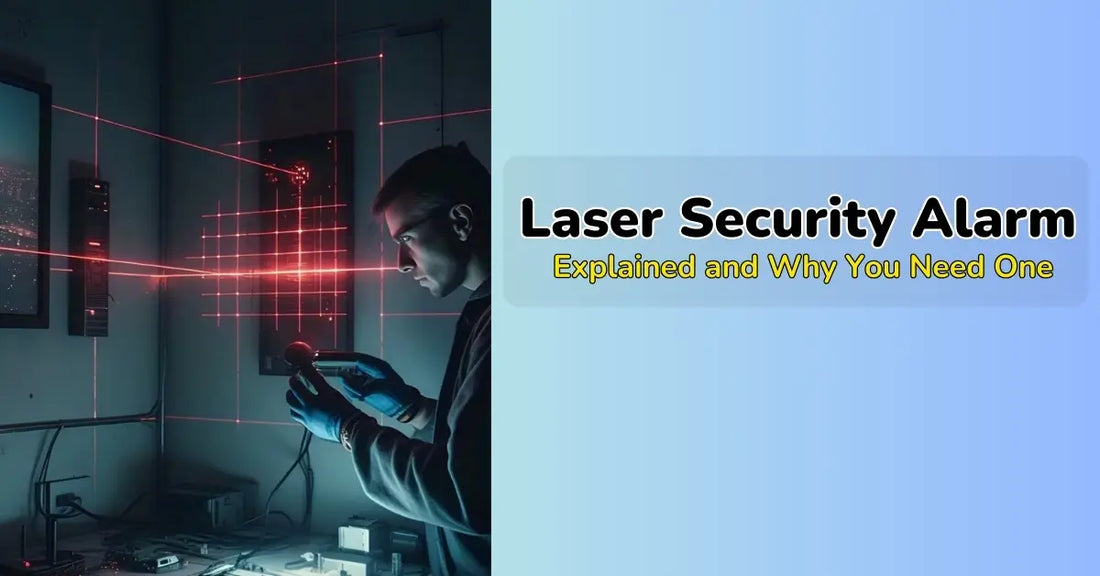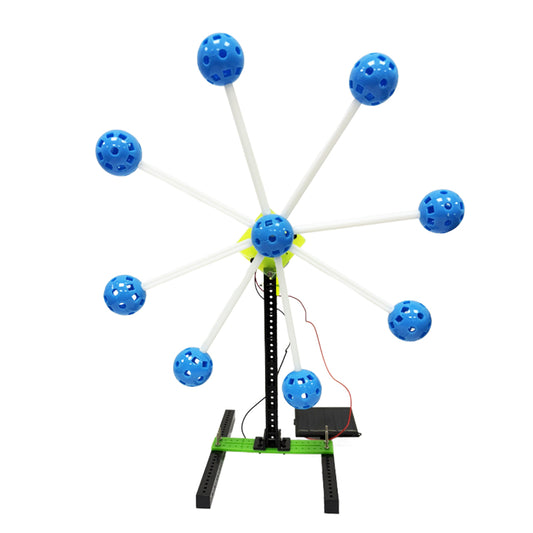
Laser Security Alarm Explained and Why You Need One
IEM RoboticsTable of Content
-
How Does a Laser Security Alarm Work?
-
How to Make Laser Security System?
- Materials Needed
-
Step-by-Step Assembly
-
Testing the System
-
Security Upgrades at a Higher Level
-
Advantages of laser security system
-
Disadvantages of laser security system
-
Laser security system for home: Enhancing Home Safety
-
How Does a Home Laser Security Work?
-
Best Places to Install a Laser Security System at Home
-
Conclusion
Laser security alarm have become integral to modern security, as traditional locks and alarms are not enough to protect homes, offices, and confidential areas. The systems use invisible laser beams to create a security perimeter, sounding an alarm when an intruder breaches the beam.
Typically used in homes, banks, museums, military bases, and industries, laser security alarm offer high precision, tamper-proof design, and simple integration with intelligent security systems. They range from home automation to large-scale industrial protection and offer instant detection with minimal false alarms.
This article will explore the operation of laser security alarm system, their components, applications, advantages and disadvantages, and even a step-by-step guide on how to make your system. If you are an engineer, a technology enthusiast, or simply wish to include security, this blog is your companion.
How Does a Laser Security Alarm Work?
The working of a laser security system is based on optical interruption detection. Following is a step-by-step explanation:
● Laser Emitter: A laser module or diode emits a continuous laser beam to a receiver (photoresistor, photodiode, or LDR).
● Alignment with the Detector: The laser beam is pointed towards the receiver, continuously monitoring for the presence of light.
● Circuit Activation: The alarm is dormant if the laser beam is passed undisturbed.
● Intrusion Detection: When an object or person traverses the beam, it is broken, and light cannot be transmitted to the receiver.
● Alarm Triggering: The receiver detects this sudden drop in light intensity and triggers the alarm (buzzer, siren, or automated alert system.
How to Make Laser Security System?
Building a DIY laser security system is an engaging project that can make you savvier about electronics and security systems. Using essential electronic components and wiring, you can create an effective laser security alarm to guard doors, windows, or any other space to which you need to limit access.
Materials Needed
- To construct a simple laser light security system, you will require:
- Laser Pointer – Serves as the light source.
- LDR (Light Dependent Resistor) – Sensing the laser beam.
- Buzzer or Alarm – Produces the sound signal when the beam is broken.
- Resistors (10kΩ and 330Ω) – Assists in controlling circuit current.
- Transistor (BC547 or equivalent) – Used as a switch to turn on the buzzer.
- Battery (9V or 12V) – Supplies power to the circuit.
- Breadboard or PCB – Used for assembling the circuit.
- Connecting Wires – To connect the components.
Step-by-Step Assembly
Step 1: Laser Setup
- Mount the laser pointer in a stable position to always project a beam toward the LDR.
- Mount it in a doorway, window, or entrance passage where detection is required.
Step 2: LDR to Circuit Connection
- Attach one end of the LDR to the VCC (positive terminal of the battery) and the other to the base of the transistor through a 10kΩ resistor.
- Also, connect the LDR's second terminal to the ground using a 330Ω resistor to form a voltage divider.
Step 3: Transistor and Buzzer Connection
The transistor collector pin is connected to the buzzer positive terminal.
- The emitter pin is connected to the ground to close the circuit.
- When the laser beam gets interrupted, the LDR resistance increases, enabling the transistor to switch on, which switches on the buzzer.
Step 4: Providing Power to the Circuit
- Power the circuit with a 9V or 12V battery.
- To make the system advanced, you can interface it with a microcontroller (Arduino or Raspberry Pi) for smartphone alerts and remote monitoring.
Testing the System
- Turn on the laser pointer and make sure it falls directly on the LDR.
- Obstruct the laser beam with your hand or any object.
- The buzzer must trigger an immediate alarm prompt if the circuit is constructed correctly.
Security Upgrades at a Higher Level
- Use a relay module for connecting the system to high voltage lamps or sirens.
- Integration programming with an Arduino to provide alarms via SMS or mobile app.
- Use a photodiode instead of the LDR to make the sensor more accurate and sensitive.
Laser Security System Circuit Diagram

Image Source Link:
https://www.circuits-diy.com/laser-security-alarm-circuit-4/
The table below summarizes the image:
|
Components |
Descriptions |
|
Title |
Laser Security Alarm Project |
|
Circuit Diagram |
Shows the electronic components and wiring for the system |
|
Laser Module |
It emits a continuous laser beam |
|
LDR (Light Dependent Resistor) |
Detects laser beam interruption |
|
Transistors (BC548) |
Used for signal amplification and switching |
|
Resistors (R1, R2, R3, R4) |
Limit current and stabilize the circuit |
|
LED (Indicator Light) |
Lights up when the circuit is active |
|
Buzzer |
Sounds an alarm when the laser beam is interrupted |
|
Switch |
Turns the circuit on/off |
|
Battery (9V) |
Provides power to the circuit |
|
Working Principle |
The laser beam continuously hits the LDR. When interrupted, resistance changes, activating the alarm |
Advantages of laser security system
The laser security alarm system project possesses many benefits that render it a reliable home and business security solution.
1. High Accuracy and Precision
Laser beams notice being interrupted immediately, offering real-time notice with fewer incorrect alarms compared to traditional motion sensors.
2. Invisible and Hard to Mask
Unlike visible fences or security cameras, laser beams are invisible to the human eye and, therefore, complex for an intruder to detect and avoid.
3. Low Maintenance
Once installed, the laser security alarm has minimal or no maintenance as it has no moving parts and is wear-and-tear-resistant.
4. Works in All Lighting Conditions
Laser beams function day and night without being affected by lighting conditions, unlike CCTV cameras, which can be affected in low light.
5. Scalable and Customizable
Laser security systems are scalable and customizable for specific areas—ranging from single-door protection to large perimeters—and can be integrated with alarms, CCTV, and smart home systems for added security.
6. Rapid and Reliable Response
Since the system is based on direct beam interruption, it provides immediate notifications, and rapid action can be initiated to prevent unauthorized access.
While laser security systems are highly accurate and reliable, users must consider some disadvantages before installing them.
Disadvantages of laser security system
1. High Cost
Laser security systems, especially those with smart integration, are costly. They are more expensive than traditional security systems due to the expense of laser emitters, sensors, wiring, control units, and installation.
2. Alignment Sensitivity
These are based on the precise alignment of the laser transmitter and receiver. Any minor vibrations, movement on the ground, or accidental interference can disrupt the system's alignment, leading to false alarms or reduced functionality.
3. Exposures to Environmental Conditions
Laser light is vulnerable to fog, heavy rain, dust, or direct sunlight, affecting accuracy. Continuous wind movement or moving objects such as leaves can trigger unnecessary alarms.
4. Limited Coverage Area
Unlike wide-coverage cameras or motion sensors, laser security alarm system protect single lines of detection. Illuminating a large property requires more than one beam, which increases the cost and difficulty of installation.
5. Bypass Risks
Though difficult to spot, cunning intruders can circumvent laser beams by employing mirrors, infrared detectors, or crawling beneath single-beam systems.
6. Power Dependency
Laser security systems need a continuous supply of power to operate. A power failure can render the system useless without auxiliary power sources such as batteries or solar panels.
The application of laser security alarm systems has revolutionized modern security by providing a highly reliable and efficient solution to prevent unauthorized access.
These systems use laser beams to create invisible barriers that trigger an alarm when disrupted, ensuring precise detection with a quick response time. Known for their accuracy, dependability, and discreet operation, laser security systems are extensively used across various sectors to enhance safety and intrusion prevention.
Laser security system for home: Enhancing Home Safety
Domestic security is becoming more critical, with rising burglary and intrusion cases rendering traditional security measures like locks and CCTV cameras ineffective. A laser security system for home provides cutting-edge protection by creating an imperceptible security wall around doors, windows, or the overall home perimeter.

Image Source Link:
https://www.circuits-diy.com/laser-security-alarm-circuit-4/
How Does a Home Laser Security Work?
● Laser sensors and emitters are placed in strategic locations such as doors, windows, and fences.
●A continuous laser beam is projected between the receiver and emitter, forming an invisible security line.
● When the intruder or object crosses the beam, it is interrupted, triggering an alarm.
●The system can be set to trigger alarms, activate lights, or send messages to homeowners and security officers.
Best Places to Install a Laser Security System at Home
Laser Light Security System should be installed at the following places for maximum protection:
Main Doors and Doorways – Alarms for unauthorized entry through doorway openings.
Windows and Balconies – Secures weak windows and balconies are customarily used by burglars.
Garden and Backyard – This creates an invisible boundary around the outdoor grounds.
Garage and Driveway – Warns homeowners if a foreign vehicle or person enters the house.
Conclusion
Laser security alarm systems provide high-precision, real-time detection for homes, businesses, and high-security areas. Their invisible, tamper-proof design and seamless integration with smart security make them a powerful defense against intrusions.
While they have some limitations, their reliability and scalability make them a wise investment. laser security alarm can significantly enhance your protection if you install a system or build a DIY version.
Want to upgrade your security today? Explore top laser security systems or consult a security expert for the best solution.








